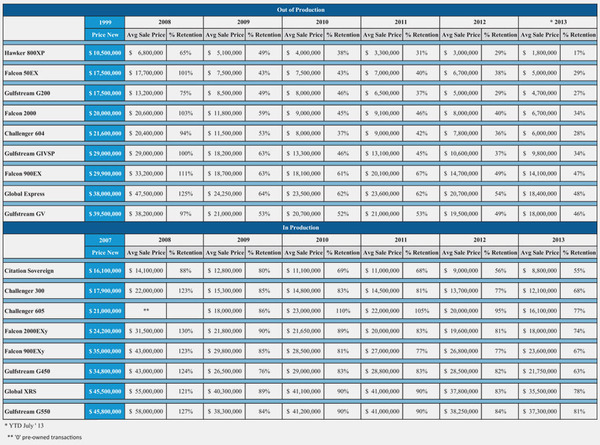 Aircraft Bluebook Marketline | Comments Off |
Aircraft Bluebook Marketline | Comments Off | MARKETLINE FALL 2013 EDITION
 Tuesday, September 10, 2013 at 2:20PM
Tuesday, September 10, 2013 at 2:20PM Vol. 26, No. 3 | Sept 10, 2013 | Go to Charts
IN THIS ISSUE
Bluebook Perspectives: Value Retention In Today's Market
Into the Blue: Penton Completes Acquisition of Aviation Week Group From McGraw Hill Financial
Ask Aircraft Bluebook: How can I submit information to Aircraft Bluebook?
[Download the full Fall 2013 Marketline Newsletter and All Charts.]
Value Retention In Today's Market:
By Dennis Rousseau | President and Founder | AircraftPost.com
 There has been conversation and many questions over the last few years relating to residual values, value retention, value as a percentage of cost new, values coming back, et al. For years, our industry used a 3 to 4 percent annualized depreciation schedule to gauge future values for business jets. Due to the fact our business was in its infancy, we did not possess formidable history to determine the validity of the schedule. When we buy-in to the fundamental assumption that aircraft are depreciating assets with a 30-year life cycle, most business jets will reflect an average midlife (15 years) value retention of 50 percent, when compared to the original cost new.
There has been conversation and many questions over the last few years relating to residual values, value retention, value as a percentage of cost new, values coming back, et al. For years, our industry used a 3 to 4 percent annualized depreciation schedule to gauge future values for business jets. Due to the fact our business was in its infancy, we did not possess formidable history to determine the validity of the schedule. When we buy-in to the fundamental assumption that aircraft are depreciating assets with a 30-year life cycle, most business jets will reflect an average midlife (15 years) value retention of 50 percent, when compared to the original cost new.
As illustrated in the data sheet, we’ve made every attempt to compare aircraft in an equal light. For out of production aircraft we use a 1999-year model reflecting 14-years in service. For current production business jets, a 2007-year model is used reflecting 6-years in service. Regardless of the term, each make/model is generating nine to ten percent annualized depreciation. For each year through 2013 we’ve calculated the average [pre-owned] selling price for the respective model. The original price new reflects the average contract price for each make/model for the stated year.
Clearly, these numbers should not be construed as ‘one size fits all.’ Each transaction and make/model comes with its own set of dynamics. However, aircraft with greater capability (higher passenger loads, transcontinental range, increased performance, later generation avionics, etc.) tend to retain a higher percentage of their original cost new. In the majority of cases, there seems to be a corollary between the total aircraft manufactured and lower resale value—the greater the number built, competitive landscape increases and value retention erodes quicker. As of July 2013, AircraftPost calculated an average ten percent of current generation business jet fleets on the market. The range is from 2 percent of the fleet for the G550 to 22 percent for the Lear 60XR. In the case of the former, an anomaly exists. There are now over 425 G550s in-service which would lend one to believe, based on the above-mentioned criteria, that early year models should be retaining less of their original cost new. Current data however, reflects the opposite.
As evidenced recently in pre-owned markets, selling prices continue a downward trend. As newer generation avionics are installed in the next iteration aircraft (i.e., Global Express/XRS/Global 6000; Lear 60/60XR; GIV/IVSP/450, etc.), these newer aircraft will place more pressure on pre-owned aircraft. The rate selling prices decline is determined in part by the above-mentioned and also driven by global economic factors. With the eroding geopolitical situation in the Middle East, South America and Asia, countries like the U.S. and Japan accruing debt of $16 and $10 trillion, respectively, it’s a wonder our markets are generating the sales they are.
Where do we go from here? In a nutshell, if our dollar continues to lose value, the price of most everything goes up. Does that include pre-owned aircraft that have been selling well under ‘normalized markets?’
Aircraft Bluebook – Price Digest here for you
Please contact Aircraft Bluebook if you have any specific concern in a particular aircraft market. We will be happy to share with you the most up-to-date information available for your market segment. Call us toll-free at 877-531-1450 or direct at 913-967-1956.



